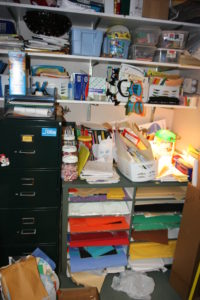
This area is in need of some decluttering. Start small, use storage containers to sort and place keep items in them.
As November comes to an end, and the weather starts to cool, teachers and staff start thinking about the holidays. However, what they probably don’t think about is their role in the IPM program. As parties are planned, decorations brought out of storage and cooler temperatures invite open windows it’s also a good time to remind everyone that mice, ants, and other critters are on the move. This time of year also brings out the clutter bug in all of us, it’s best to keep on top of this behavior then let it take over one’s life.
De-cluttering has the immediate effect of eliminating pest harborage. When clutter is reduced, there is increased access to floor spaces, allowing for more thorough cleaning by custodial staff. The same is true for shelves and inside cupboards. When there are nooks and crannies – created by “stuff” – for pests to hide and breed among, there will be allergens and lots of bugs.
Clutter control also helps improve overall school hygiene. It’s easier for custodial staff to sweep, mop, and dust when things are generally organized. Minimizing clutter also helps teachers stay organized. It’s much easier to keep your room tidy when your cupboards and bookshelves are not overflowing with stuff!
HOW do you de-clutter a school?
Kitchen staff
While food preparation and cooking lends itself to keeping areas clean. Kitchens often harbor some of the worst pest problems
simply due to the fact that food, water, and harborage are in high demand. Keeping an eye out for potential pest problems is essential to a sustainable integrated pest management (IPM) program.
- Do not use corrugated cardboard for long term storage. German cockroaches are actually brought inside our schools hiding in the corrugations. They actually feed on the glue starch that holds the boxes together. Rotate out all corrugated cardboard if possible.
- Keep pantry shelving free of needless debris. Emptied supply boxes should be broken down and recycled rapidly.
- Clutter is also a problem around and in drains: debris blocking and clogging up drains can not only lead to maintenance issues, but drain flies love to breed in the scum that accumulates around the edges (and bleach won’t help!). Make sure all drains have covers, especially sink drains. Those heavy duty metal sink-drain baskets that can be washed in the dishwasher or sink to help eliminate organic matter.
Custodians
Though you are the sanitarians of your schools, in general you are not responsible for de-cluttering areas other than your own. Custodians can set a great president by maintaining well organized custodial closets.
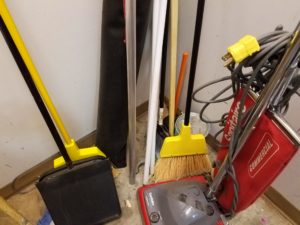
In this closet cockroaches, spiders, and ants could go undetected for long time without anyone noticing.
- Hang brooms and mops on a wall rack so that mops can drain of moisture; brooms & mops are pest havens as they contain food, moisture, and a protected
area in which to feed & breed.
- Get good shelving! Too often, custodians have no shelving or organizational features in their closets. However, this is a “pest vulnerable area” and without organization it can lead to a rapid decline toward bugs, dirt and filth. Shelves should be wire (not wood), with the bottom shelf a minimum of 6” off the ground to allow for cleaning under. Use the IPM program you are part of as leverage for good quality shelving that will get your school on the right track.
- Make sure your storage closets are not reservoirs for cans of illicit pesticide sprays, from classrooms or elsewhere. Remember only licensed applicators should make pesticide applications in your schools and should also consult with the IPM coordinator.
Teachers
As the educators in your school, you have a great opportunity to set an example for students and staff. Get the kids to help out with the following suggestions, too!
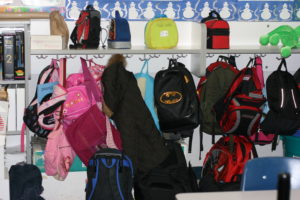
Storage space is limited but beware that when bed bugs or lice are a problem – space is a better option.
- Art supplies – Cockroaches dine on glue, and crickets, termites, booklice and silverfish (among others) will readily consume paper. Just think about what the can do with macaroni noodles and rice! Keep glue containers clean and capped. Store art supplies in plastic pest-proof containers, such as Tupperware or Rubbermaid, with tight-fitting lids.
- Storage closets – have you ever seen a well-organized teacher’s closet? We have and generally they belong to the best of the best teachers we know. We appreciate that it’s tough for teachers to create projects and educate on a budget; of course you want to keep all that stuff! But ask yourself one question: have you used it in the last 2 years? If the answer is no, then toss (or recycle) it. This goes for the rest of your classroom, too. No cheating by stuffing storage bins full of things you plan to get to “one day”. Benefit from the extra space and let the clutter go!
- For everything that’s left, organize it and store it in plastic tubs with tight-fitting lids. No boxes – you’re importing cockroaches AND feeding them when you use corrugated cardboard!
- End-of-week 15 minute desk clean off. Think “file not pile”. Documents go in one of 3 places: the file cabinet, recycle bin, or trash. Have students do this with their desks as well! You will thank yourself at the end of the year, as your overall clean up time will not be measured in days, but hours.
IPM coordinators to help with your education program – download and share this handout with all of your staff Clutter in the Classroom Handout

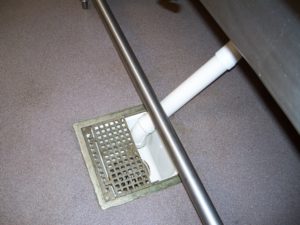
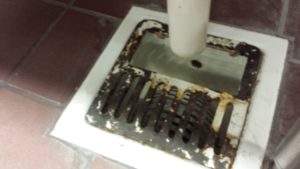
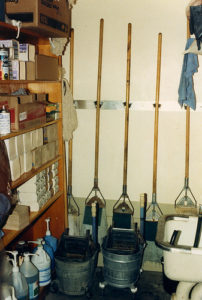
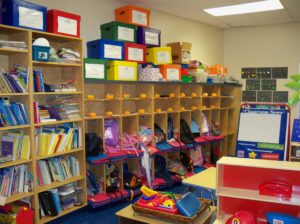
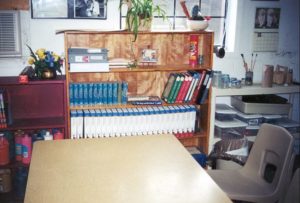

 .
.